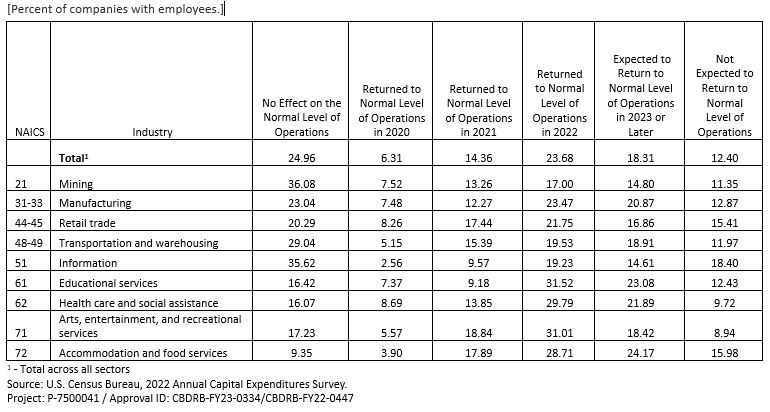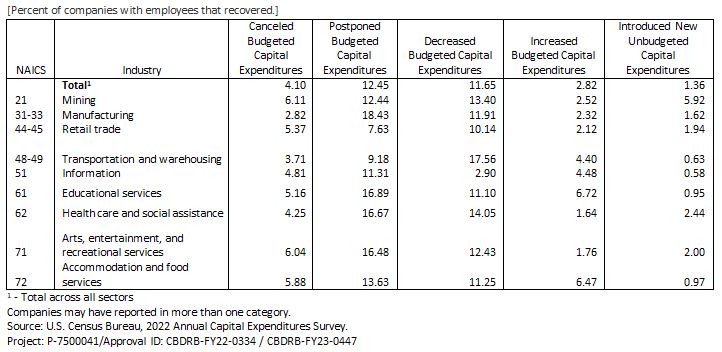Impacts of the COVID-19 Pandemic on Business Operations (2022)
Impacts of the COVID-19 Pandemic on Business Operations (2022)
As part of the 2022 Annual Capital Expenditures Survey (ACES), questions were asked to gather information measuring the effect of changing business conditions since the Coronavirus Pandemic began in 2020. The tables provide an indication of if/when businesses returned to normal levels of operations after the pandemic began in 2020 and the changes made to budgeted capital expenditures to return to normal level of operations for U.S. companies with employees. Normal level of operations are based on sales, revenue, shipments, profit, or employment before the Coronavirus pandemic. All data are available at the national level by 2-digit North American Industry Classification System (NAICS) industry sector.

In 2022, 6.3 percent of companies reported that they returned to their normal level of operations in 2020; 14.4 percent returned to their normal level of operations in 2021; 23.7 percent returned to their normal level of operations in 2022; 18.3 percent reported that they expected to return to their normal level of operations in 2023 or later; and 12.4 percent reported that they do not expect to return to their normal level of operations. A total of 25.0 percent of companies reported that there has been no effect on their normal level of operations since the Coronavirus pandemic began in 2020.
Sector Highlights
- Returned to normal level of operations in 2020 – Mining (7.5 percent); Manufacturing (7.5 percent); Retail trade (8.3 percent); Transportation and warehousing (5.1 percent); Information (4.0 percent); Educational services (5.9 percent); Health care and social assistance (5.6 percent); Arts, entertainment, and recreational services (4.2 percent); and Accommodation and food services (5.0 percent).
- Returned to normal level of operations in 2021 - Mining (13.3 percent); Manufacturing (12.3 percent); Retail trade (17.4 percent); Transportation and warehousing (16.4 percent); Information (9.6 percent); Educational services (9.2 percent); Health care and social assistance (13.9 percent); Arts, entertainment, and recreational services (18.8 percent); and Accommodation and food services (17.9 percent).
- Returned to normal level of operations in 2022 – Mining (17.0 percent); Manufacturing (23.5 percent), Retail trade (21.8 percent); Transportation and warehousing (19.5 percent); Information (19.2 percent); Educational services (31.5 percent); Healthcare and social assistance (29.8 percent); Arts, entertainment, and recreational services (31.0 percent); and Accommodation and food services (28.7 percent).
- Expect to return to normal level of operations in 2023 or later – Mining (14.8 percent); Manufacturing (20.9 percent); Retail trade (16.9 percent); Transportation and warehousing (18.9 percent); Information (14.6 percent); Educational services (23.1 percent); Healthcare and social assistance (21.9 percent); Arts, entertainment, and recreational services (18.4 percent); and Accommodation and food services (24.2 percent).
- Do not expect to return to normal level of operations - Mining (11.4 percent); Manufacturing (12.9 percent); Retail trade (15.4 percent); Transportation and warehousing (12.0 percent); Information (18.4 percent); Educational services (12.4 percent); Healthcare and social assistance (9.7 percent); Arts, entertainment, and recreational services (8.9 percent); and Accommodation and food services (16.0 percent).

In 2022, of those companies that were impacted by the coronavirus pandemic but had returned to normal level of operations in 2020, 2021 or 2022, 4.1 percent of companies canceled, 12.45 percent postponed, 11.65 percent decreased, and 2.8 increased some of their budgeted capital expenditures during the coronavirus pandemic. A total of 1.4 percent of companies introduced new unbudgeted capital expenditures.
Sector Highlights
- Canceled budgeted capital expenditures – Mining (6.1 percent); Manufacturing (2.8 percent); Retail trade (5.4 percent); Transportation and warehousing (3.7 percent); Information (4.8 percent); Educational services (5.2 percent); Health care and social assistance (4.3 percent); Arts, entertainment, and recreational services (6.0 percent); and Accommodation and food services (5.9 percent).
- Postponed budgeted capital expenditures - Mining (12.4 percent); Manufacturing (18.4 percent); Retail trade (7.6 percent); Transportation and warehousing (9.2 percent); Information (11.3 percent); Educational services (16.9 percent); Health care and social assistance (16.7 percent); Arts, entertainment, and recreational services (16.5 percent); and Accommodation and food services (13.6 percent).
- Decreased budgeted capital expenditures – Mining (13.4 percent); Manufacturing (11.9 percent), Retail trade (10.1 percent); Transportation and warehousing (17.6 percent); Information (2.9 percent); Educational services (11.1 percent); Healthcare and social assistance (14.1 percent); Arts, entertainment, and recreational services (12.4 percent); and Accommodation and food services (11.3 percent).
- Increased budgeted capital expenditures – Mining (2.5 percent); Manufacturing (2.3 percent); Retail trade (2.1 percent); Transportation and warehousing (4.4 percent); Information (4.5 percent); Educational services (6.7 percent); Healthcare and social assistance (1.6 percent); Arts, entertainment, and recreational services (1.8 percent); and Accommodation and food services (6.5 percent).
- Introduced new unbudgeted capital expenditures - Mining (5.9 percent); Manufacturing (1.6 percent); Retail trade (1.9 percent); Transportation and warehousing (0.6 percent); Information (0.6 percent); Educational services (0.9 percent); Healthcare and social assistance (2.4 percent); Arts, entertainment, and recreational services (2.0 percent); and Accommodation and food services (1.0 percent).





